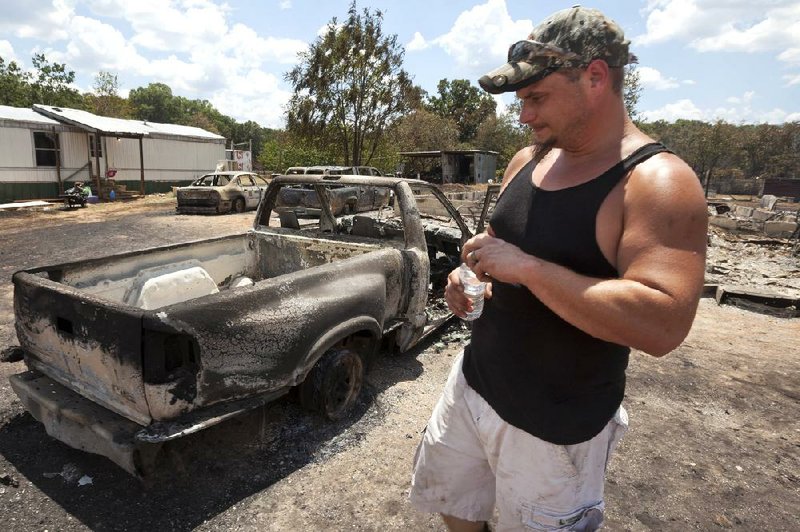LITTLE ROCK — This summer’s searing heat and low rainfall totals have created one of the worst droughts in Arkansas since the 1980s, weather experts said.
Most of the state was designated Thursday as in severe drought or worse, according to the National Drought Mitigation Center in Lincoln, Neb.
More than 75 percent of Arkansas was listed as in extreme drought, and 33 percent fell into the exceptional drought category, the highest on the center’s scale.
The center ranks the severity of drought on the basis of rainfall received in an area in a month as compared with normal rainfall totals for the month.
Severe drought pertains when rainfall for an area is 3-4 inches below normal for the month. An area is in extreme drought when rainfall totals are 4 inches or more below normal for the month. Exceptional drought is considered a shortfall of 5 inches of rain or more.
Just three months ago, the entire state was droughtfree.
Then it stopped raining.
Rainfall deficits are as high as 10 inches for the year in Northwest Arkansas and are approaching 9 inches in the central and southern regions, according to the National Weather Service in North Little Rock.
As a result, the fire danger is high across the state. Fiftyeight counties are under burn bans, according to the Arkansas Forestry Commission.
Across the United States, the drought is intensifying and shows little signs of ending soon, drought mitigation center officials said Thursday.
The drought report showed that the amount of U.S. land classified in extreme or exceptional drought jumped to more than 20 percent, up 7 percent from last week.
More than 63 percent of the continental United States is in some stage of drought, a portion unseen since the Drought Monitor started in 1999, the report said.
As for the historical significance of this year’s drought, John Robinson, warning coordinator with the National Weather Service in North Little Rock, said the current drought ranks with those of 1954 and 1980, though “it would have to be this dry for several years to match what we saw in the 1950s.”
In Hot Springs, Garland County Judge Rick Davis said he continues to pray for drought relief.
Many ranchers in the county are selling some of their livestock herds because they can’t afford to feed them, and the hay supply is already depleted in many cases, he said.
“It’s a very serious situation,” Davis said. “Livestock ponds that have never dried up before are now dry. It’s becoming very difficult for some of our ranchers to stay in business.”
White County Judge Michael Lincoln compared the heat and wind in his county to a blast furnace that “scorches everything in its path.”
He said hayfields there are nothing more than brittle, lifeless open spaces.
“I don’t ever remember anything like this,” Lincoln said. “You can water the ground, but it doesn’t do any good. Livestock farmers are having trouble finding hay, and our sale barns are overrun with people selling off their cattle because they can’t afford to feed them.”
Mary Hightower, spokesman for the University of Arkansas System Agriculture Division, said farmers and ranchers across the state are hurting because of the extremely dry conditions.
The drought has “driven the life out of the state’s pastures ... and is drying out stock and irrigation ponds” all over Arkansas, Hightower said.
“Water tables are declining rapidly, especially in western Arkansas and the Arkansas River Valley.”
Though cattle producers have been hardest hit, poultry growers are beginning to feel the drought, as well.
“The heat has been tough on farmers worried about water shortages for their poultry farms,” Susan Watkins, extension poultry specialist for the UA Agriculture Division, said in a news release issued Thursday.
“It’s not epidemic, but it is a concern with the drought that surface water sources such as ponds are drying up and with the heat some wells are having trouble keeping up with the required volume for raising big birds and cooling with the evaporative cool cells.”
Watkins noted in the release that many poultry farmers using municipal or rural water are being asked to go off the systems because the suppliers can’t keep up with usage demands.
The Associated Press reported Thursday that House Republican leaders in Washington are expected to take up legislation next week to help farmers and ranchers — particularly livestock producers — hit by the drought.
Dry conditions have also caused the Mississippi River to drop about 13 feet below normal, and it is forecast to fall about 2.5 feet more by Aug. 22, according the U.S. Army Corps of Engineers in Memphis.
To deal with the falling river, Corps survey boats are teaming up with government and commercial dredges to dig out sand and silt and ensure that the navigation channel is deep enough for barges loaded with coal, steel, agricultural products and other goods.
Meanwhile, the upper half of Arkansas saw a little relief Thursday afternoon and evening as showers and thunderstorms popped up.
But Robinson said they were far from being “drought busters,” and dry conditions will return as soon as a high pressure system settles back over Arkansas by next week. That system, which is currently over Colorado, is to blame for Arkansas’ recent lack of rainfall.
Triple-digit heat will continue baking much of the state next week, according to a recent National Weather Service forecast.
“Just look for more of the same, with things getting a little worse,” Robinson said. “It’s going to be hot and dry. And we aren’t even into August yet.”
Front Section, Pages 1 on 07/27/2012

